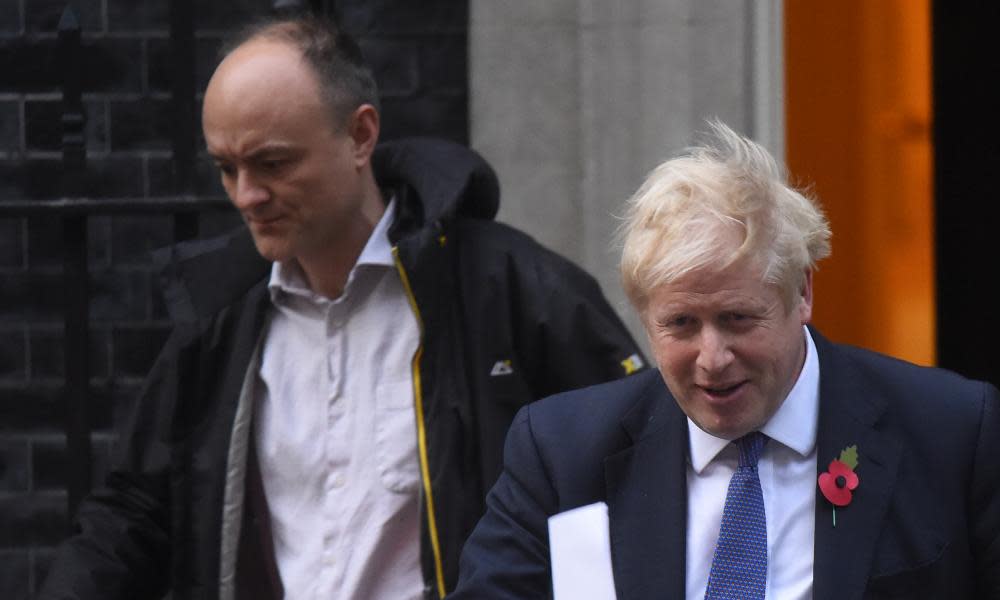Post-Cummings quiet life goes to pot as ‘No 10 sources’ leak and brief

When Dominic Cummings and Lee Cain departed Downing Street and the understated former Treasury official Dan Rosenfeld was swiftly installed as chief of staff, the message seemed clear: enough bickering, feuds and drama, it’s time for a quieter life.
Five months on, it’s fair to say this has not gone to plan, or not entirely.
Some elements of No 10 life are more serene, particularly day-to-day relations with the media, previously marked by incidents such as a mass boycott of an official briefing after Cain, the head of communications, tried to handpick which reporters could attend.
The winding back of the Cummings/Cain template for reshaping government messaging has brought its own hiccups, however, not least this week’s axing of a plan to hold daily televised briefings with the press secretary, Allegra Stratton, but only after a £2.6m media hub was built inside 9 Downing Street.
But if the hope was to eradicate the factionalism around Boris Johnson, with the near-daily rounds of anonymous media briefings from well-informed if suspiciously partisan “No 10 sources”, this week has shown that it was, at best, a temporary halt to proceedings.
Related: Dominic Cummings launches attack on Boris Johnson
As ever it was Cummings, Johnson’s former chief aide, at the centre of it all. In a notable chronology, Downing Street officials announced an inquiry on Thursday into the leaking of text messages between Johnson and the billionaire vacuum cleaner magnate, James DysonHours later, those “No 10 sources” re-emerged to identify the supposed culprit as Cummings.
The briefing was a curious mix of the deeply personal – Cummings was described as bitter that Johnson’s government had thrived since his departure – and the highly organised, with near-identical quotes released simultaneously, under a strict 10.15pm embargo, to three friendly newspapers.
This salvo inevitably sparked a rush of counter-briefings, both denying that Cummings was the leaker and then, in something of a return to the classic era of vivid language from the his camp, a warning that Downing Street was like America going into Vietnam and “the rebel always wins”.
Cummings finally broke his silence to name Jack Doyle, recently promoted to the head of communications job formerly held by Cain, as the source of what he said were false accusations against him.
Never one to go down without a fight, Cummings denied in a blog post published on Friday afternoon that he was the source of the Dyson leak. He also accused the Number 10 staffer Henry Newman and apparent friend of the prime minister’s fiancee, Carrie Symonds, of being the mole behind another leak last year concerning England’s second national lockdown.
Cummings recounted that Johnson was worried about having to sack Newman, so wanted to shut down the leak inquiry, and that he had proof in the form of “WhatsApp messages with very senior officials about this matter which are definitive”.
Related: Leak inquiry launched as No 10 insiders accuse Dominic Cummings
Cummings also confirmed Johnson had told him of plans to have “donors secretly pay” for renovations to the flat above No11 where he, Symonds and their son Wilf live, called for an urgent inquiry into the government’s conduct of the Covid crisis, and accused the prime minister and his office of falling “below the standards of competence and integrity the country deserves”.
However dramatic, the flurry of animated attacks illustrates the aspects of No 10 life which have not changed under the new officials.
Part of this is the very loyal camp centred around Symonds who is a well-connected Conservative party veteran, and to an extent around Stratton, who with the demise of the TV briefings is to take the media lead for the Cop26 climate summit in Glasgow this autumn.
Downing Street explicitly chose not to deny responsibility for the anti-Cummings briefing. Johnson’s spokesperson refused to answer questions about it, but some sources claim it originated mainly from officials associated with Symonds, who was bitterly opposed to Cummings and seen as central to his departure.
The row also highlights the fact that while the post-Cummings No 10 is arguably less fractious, it has not been notably less chaotic, shaken by a series of leaked private messages sent to and from the prime minister, and by a torrent of revelations about lobbying, not least connected to David Cameron.
In politics, flux is usually associated with a breakdown in message discipline, and recent weeks inside No 10 have proved no exception.
One of the more odd episodes came last Sunday, when yet more unnamed sources explained to the Mail on Sunday the theory that the leaks came from a cell of Labour-supporting senior civil servants who were “activated” by their handlers because of Cummings’ stated desire to reform Whitehall officialdom. The mole was even given a name, Redthroat.
It remains to be seen whether the leak inquiry, one of several launched inside Downing Street in the Johnson era, unearths Redthroat, or identifies Cummings as the source. But one thing is clear. The drama is far from over.

 Yahoo Movies
Yahoo Movies 
